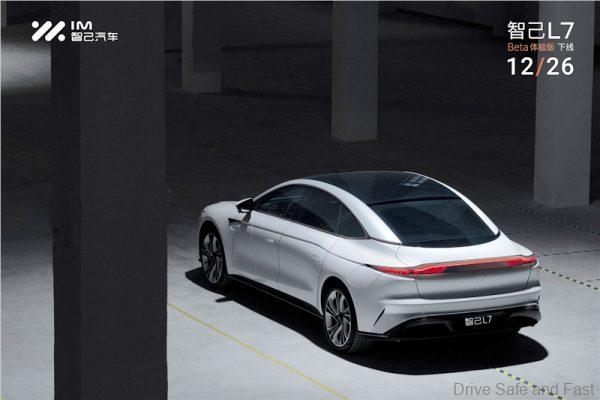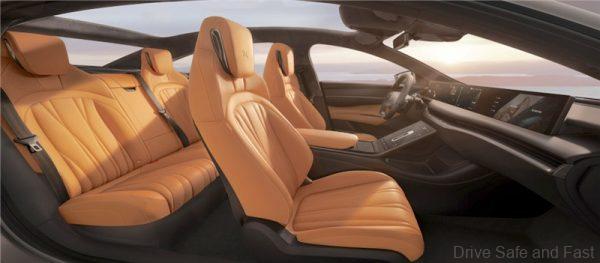The IM Motors L7 Beta will be running “data burn-in” for the next month to ensure things work.
Chinese car companies are quite willing to work with tech companies to create new car brands with cutting edge technologies. We’ve seen Huawei work with Seres and with Changan on new car platforms and technology. Now, we’re seeing Alibaba and SAIC work together on a brand called IM Motors, which has just released their model ‘L7’ for beta testing in 9 Chinese cities.

These first 200 IM L7 Beta testing vehicles will undergo what is called “data burn-in”, which is part of the development process of vehicles with artificial intelligence built in. This means that the L7 Beta is legally allowed to operate on public roads, but an extended testing phase in Shanghai, Bund, Lujiazui and other commercial districts will be conducted to optimise sensory and perceptual systems, domain controller software, and human-computer interactions for the final production cars.

Data burn-in uses data collected from real-world scenarios to test the performance of deep intelligent vehicles to improve the user experience. IM Motors says this is what helps distinguish upcoming intelligent vehicles from the ones we have today.

After a month of “data burn-in”, IM Motors will open the IM L7 for test drives and bookings on the market. By March 2022, the company hopes to start deliveries.

Besides “data burn-in”, here’s what IM Motors says is part of the development model of intelligent vehicles:

Agile development: IM manufactured intelligent vehicles in 22 months
IM spent only 22 months producing its first intelligent vehicle and forged a mature and replicable development model called agile development for deep intelligent vehicles.
The four product architectures first used by IM L7 is the underlying innovation as well as the major problems encountered in vehicle development. The “origin” high-end pure electric architecture iO enables advanced four-wheel steering and four-wheel drive; the domain fusion central computing digital architecture with 521 features supports OTA; the atomic software architecture SOA breaks down the boundaries between functions from the bottom up; the intelligent driving system IM AD offers users the “most human-like” intelligent driving.
Agile development sets a successful example for the development model of intelligent electronic products. Faced with development challenges, IM learned from the Internet sector’s successful experience in agile development to reduce development time through simultaneous design, development, integration, and iteration.
IM also cooperated with SAIC Motor Passenger Vehicle Company, SAIC Motor Technical Center, Z-One, Banma, Momenta, and Huayu Automotive Body Components Technology (Shanghai) Companies to improve development quality and efficiency.
Over the past month, the software architecture of IM L7 has undergone 88 iterations. The intelligent driving function software iterates every three days and the IM app is updated every two weeks.
Three new benchmarks define intelligent vehicles in the AI era
Following the principle of data-determined experience and software-defined vehicle, IM creates three new benchmarks for intelligent vehicles via data training, cross-domain fusion, and full-stack OTA.
The vehicle with the “most human-like” intelligent driving by data training is a real deep intelligent vehicle. IM has built a data factory to achieve a complete data-driven process in terms of perception, fusion, prediction, and specification control, forming a closed value loop.
Based on large amounts of user data, the intelligent driving system IM AD showcases the “most human-like” intelligent driving performance with AI super algorithms.
The vehicle with scenario-based intelligent interaction by cross-domain fusion is a real deep intelligent vehicle. IM L7 connects all control domains and realizes the cross-domain fusion of intelligent scenarios.
For example, the navigation function on the interface of IM L7 operating system IMOS connects the intelligent driving domain with the intelligent cockpit domain. When driving on complicated urban roads, all road information will be displayed on the screen, creating an easier and safer driving experience.
The vehicle with up-to-date functions by full-stack OTA is a real deep intelligent vehicle. IM L7 has more than 40 modules covered with OTA, allowing large vehicle-mounted domain systems, including intelligent driving, intelligent cockpit, and chassis, as well as small function modules, including Car-log and airbag, to be updated.
FOTA is updated every three months while SOTA is updated in real time. The modules have their backups in A and B zones.
IM will launch a private test plan for IM L7 Beta in the coming days and users participating in IM Motors’ angel round investment and A-round financing are invited to apply for the test on the IM app.
